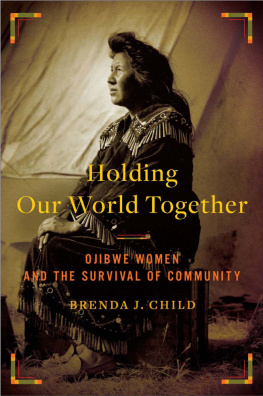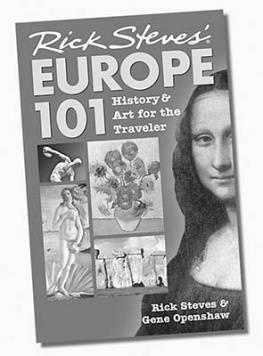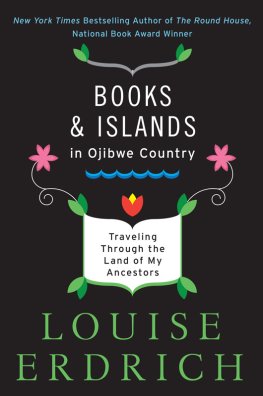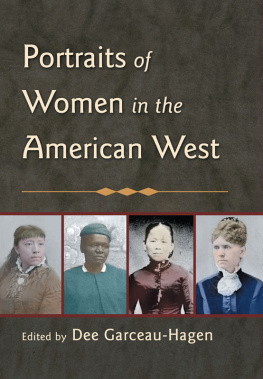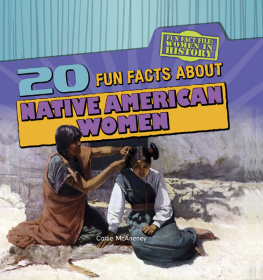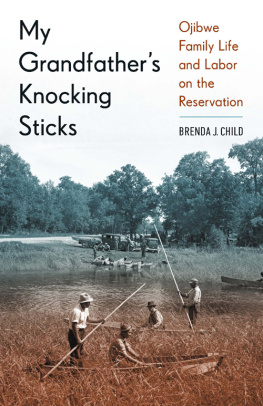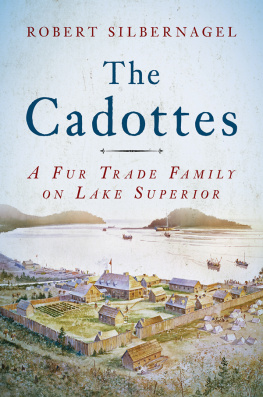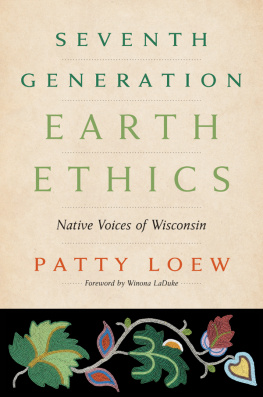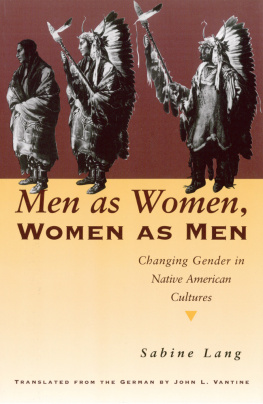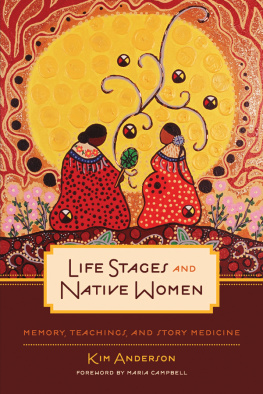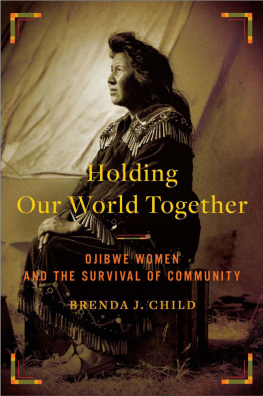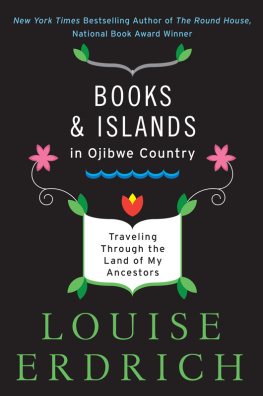HOLDING OUR WORLD
TOGETHER


OTHER TITLES IN THE
PENGUIN LIBRARY OF AMERICAN INDIAN HISTORY
The Cherokee Nation and the Trail of Tears
Theda Purdue and Michael D. Green
The Shawnees and the War for America
Colin G. Calloway
American Indians and the Law
N. Bruce Duthu
Iroquois Diplomacy on the Early American Frontier
Timothy J. Shannon
Cahokia: Ancient Americas Great City on the Mississippi
Timothy R. Pauketat
The Lakotas and the Black Hills
Jeffrey Ostler
G ENERAL E DITOR : C OLIN G. C ALLOWAY
Advisory Board: Brenda J. Child, Philip J. Deloria, Frederick E. Hoxie
HOLDING OUR WORLD
TOGETHER

Ojibwe Women
and the
Survival of Community
BRENDA J. CHILD

T H E P E N G U I N L I B R A R Y
O F A M E R I C A N I N D I A N H I S T O R Y

V I K I N G
V I K I N G
Published by the Penguin Group
Penguin Group (USA) Inc., 375 Hudson Street, New York, New York 10014, U.S.A.
Penguin Group (Canada), 90 Eglinton Avenue East, Suite 700, Toronto, Ontario,
Canada M4P 2Y3 (a division of Pearson Penguin Canada Inc.)
Penguin Books Ltd, 80 Strand, London WC2R 0RL, England
Penguin Ireland, 25 St Stephens Green, Dublin 2, Ireland (a division of Penguin Books Ltd)
Penguin Books Australia Ltd, 250 Camberwell Road, Camberwell, Victoria 3124, Australia (a division of Pearson Australia Group Pty Ltd)
Penguin Books India Pvt Ltd, 11 Community Centre, Panchsheel Park, New Delhi 110 017, India
Penguin Group (NZ), 67 Apollo Drive, Rosedale, Auckland 0632,
New Zealand (a division of Pearson New Zealand Ltd)
Penguin Books (South Africa) (Pty) Ltd, 24 Sturdee Avenue,
Rosebank, Johannesburg 2196, South Africa
Penguin Books Ltd, Registered Offices: 80 Strand, London WC2R 0RL, England
First published in 2012 by Viking Penguin, a member of Penguin Group (USA) Inc.
1 3 5 7 9 10 8 6 4 2
Copyright Brenda J. Child, 2012
All rights reserved. No part of this book may be reproduced, scanned, or distributed in any printed or electronic form without permission. Please do not participate in or encourage piracy of copyrighted materials in violation of the authors rights. Purchase only authorized editions.
L I B R A R Y O F C O N G R E S S C A T A L O G I N G - I N - P U B L I C A T I O N D A T A
Child, Brenda J., 1959
Holding our world together : Ojibwe women and the survival of community / Brenda J. Child.
p. cm. (Penguin library of American Indian history)
Includes bibliographical references and index.
ISBN: 9781101560259
1. Ojibwa womenHistory. 2. Ojibwa womenSocial conditions. 3. Ojibwa women
Economic conditions. I. Title. E99.C6C48 2011 977.00497333dc23 2011036175
Printed in the United States of America
Set in Granjon LT Std
While the author has made every effort to provide accurate telephone numbers and Internet addresses at the time of publication, neither the publisher nor the author assumes any responsibility for errors, or for changes that occur after publication. Further, publisher does not have any control over and does not assume any responsibility for author or third-party Web sites or their content.
ALWAYS LEARNING
PEARSON
To Benay Jeanette,
and her generation of
jingle dress dancers
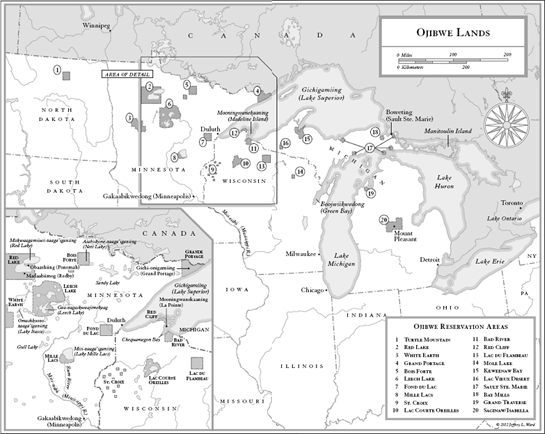
INTRODUCTION
Maps of Birch Bark

O JIBWE COMMUNITIES in the United States and Canada are linked historically through kinship, language, culture, politics, and identity. They also share a memory of a time many generations ago when their Anishinaabeg ancestors migrated from the St. Lawrence River to the Straits of Mackinac, a narrow waterway that connects Lake Huron and Lake Michigan, separating Michigans Upper and Lower Peninsulas. Maps of birch bark preserved their migration stories. Michilimackinac (the Great Turtle), an island in the straits with a prominent mounded form, was famous for the pike, sturgeon, and whitefish that swam in the cold, blue waters, and it remained for many years the nucleus of the Great Lakes Indian world. Michilimackinac proved to be a momentous place in the Anishinaabegs journey to their homelands, for it was here that the Ojibwe parted from their relatives, the Potawatomi and the Ottawa. The Ojibwe settled at Boweting, the outlet of Gichigamiing (Lake Superior) later referred to by French settlers as Sault Ste. Marie. In the early seventeenth century, a portion of the Boweting population moved west to form a significant southern Ojibwe settlement that became known after the fur trade as the village of La Pointe, on Lake Superiors Madeline Island, in present-day Wisconsins
After their historic journey up the waterways of the Great Lakes around the time of Columbus, Ojibwe clans found economic opportunity and resources that allowed them to spread over a vast region of central North America, constructing communities that by the middle of the eighteenth century were located north of Lake Ontario, around Lake Huron and Georgian Bay, and north of Lake Michigan. The Ojibwe settled on all sides of Lake Superior and as far west as Red Lake, in present-day Minnesota. Ojibwe people who lived near the Minnesota headwaters of one great river named it the Misi-ziibii, or Mississippi. Anishinaabewaki, or Ojibwe territory, spanned both sides of an international border being defined in the aftermath of the American Revolution, a delineation that initially had little consequence for the Ojibwe. They and neighboring nations inhabited a landscape encompassing the Great Lakes as well as the surrounding land and the waters that flow into them; rivers and lakes formed the main roads on the map of Anishinaabewaki.
This book is a history of Ojibwe community life in the Great Lakes since the early nineteenth century, one that unites historical sources featuring the words and experiences of generations of Ojibwe women, especially near Gichigamiing and the Mississippi, where a gendered economy founded on wild rice flourished. The Ojibwe entry into the wild rice district was a milestone marking the end of a journey. With the renewal of community life in the western Great Lakes, Ojibwe women began to hold an important and unique place in their cultures. They inhabited a world in which the earth was gendered female, and they played powerful roles as healers. They organized labor within their community and held property rights over water, making decisions and controlling an essential part of the seasonal economy. Ojibwe women lived in a society that valued an entire system of beliefs associated with womens work, not just the product of their labor.
When Europeans settled in the Great Lakes, and with the beginning of the fur trade economy in the eighteenth century, Indian women were often positioned as political, social, and economic intermediaries between their people and the newcomers. Women married traders, bridged cultures, and worked to resolve disputes, ensuring sustenance and survival for both their people and the Europeans in an era increasingly complicated by the demands of Western intrusion. Indian womens lives grew ever more complex during the removal and reservation years, when indigenous political and cultural sovereignty were being undermined by the authority of the U.S. government and Christian organizations. For the Ojibwe, colonial violence against people and the land during the reservation and assimilation era, which began in the nineteenth century, put in jeopardy their traditional economy. This had many repercussions for Ojibwe society, and men and women began to negotiate new labor roles within their communities.
Next page
